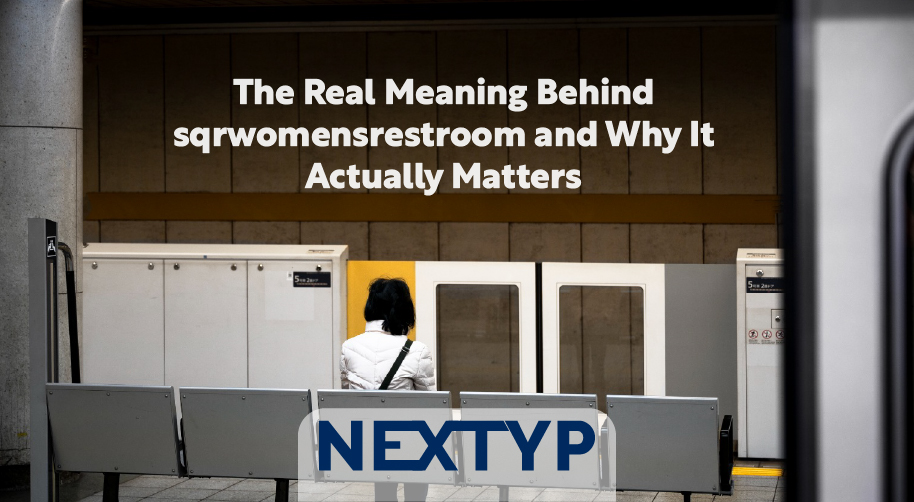If you’ve scrolled through social media or a facilities blog recently you might’ve seen the word sqrwomensrestroom pop up somewhere and thought, okay… what even is that. It sounds like some sort of techy building code term, right? But really, it’s just a new way to describe modern womens restrooms that are safer, cleaner and a lot smarter than the old ones we’re all used to.
The word kinda breaks down like this: SQR stands for “Smart Quality Restroom” (some people say it means Secure or Square) and the rest, well, speaks for itself. Basically, it’s a restroom for women that uses technology, thoughtful design and better hygiene systems to make the experience less stressful and way more hygienic.
It might sound small, but the truth is public restrooms say alot about how inclusive and modern a building really is.
What Is a SqrWomenRestroom Anyway
In the simplest terms, a sqrwomensrestroom is a women’s restroom that’s been reimagined with smarter design. Everything from layout, lighting, privacy, and tech is planned to make it easier and cleaner to use.
Imagine walking in and the air’s fresh, the floor dry, there’s no line of people bumping into each other. The sink turns on without touching it, stalls are fully closed for privacy, and maybe there’s even a small screen showing which ones are free. That’s what people mean when they talk about a sqrwomensrestroom.
According to the U.S. General Services Administration, public restroom innovation is focusing more on accessibility, hands-free features and energy efficient systems. The sqrwomensrestroom idea pretty much follows that same direction but adds a bit more attention to women’s specific needs.
Why Women’s Restrooms Needed a Redo
Honestly, women’s restrooms have had problems forever. Too few stalls, bad lighting, no baby-changing areas, awkward layouts that cause long lines. Half the time there’s no hook to hang your bag or coat.
Traditional restrooms were designed decades ago by people who didn’t really think about how women actually use them. So the sqrwomensrestroom is a kind of correction. It’s not about making it fancy, it’s about making it right.
These restrooms usually have floor-to-ceiling partitions, touchless sinks, better air circulation, and lighting that makes the space feel safe. Some even include small zones for nursing or baby changing.
It’s about comfort, yes, but also about dignity and safety.
How It’s Designed
The design usually follows a simple, square layout (that’s part of where the SQR comes from). Stalls and sinks are arranged so people don’t bump into each other when entering or leaving. It’s all about smooth flow.
Privacy and safety come next. Instead of half doors or gaps, partitions run full height. Locks are solid, and lighting is bright enough to feel safe but not blinding. Some places even add an emergency button near one stall so users can ask for help without shouting.
Tech is another piece. Touchless faucets, soap dispensers, and self-flushing toilets mean less contact with germs. Some restrooms have smart sensors that track when cleaning’s needed or if supplies are running low.
Inclusivity’s built in too. You’ll find accessible stalls, baby changing tables, and signs in braille. It’s all made for real users, not just checkboxes on a plan.
Even sustainability gets attention. Energy-saving LED lights, motion sensors and low-flow fixtures reduce waste and cut costs for building owners.
Real World Examples
Even though you might not see the exact word sqrwomensrestroom written on a door, the idea’s already in motion.
Airports like Singapore Changi and Tokyo Haneda have installed smart restrooms with real-time sensors that measure cleanliness and air quality. In the U.S., the GSA and other public agencies are testing similar systems in government buildings.
Many tech companies are following suit too. Some offices use small digital boards outside restrooms that show if a stall’s free. It sounds over the top, but when you’re in a rush, it’s kinda genius.
The Upsides and Downsides
There’s lots of good stuff about this approach. It’s cleaner, more private, and just feels more comfortable to use. Smart fixtures save water and electricity, and buildings get fewer maintenance complaints.
But yeah, there’s a few downsides too. The cost can be high at first, especially if you’re upgrading an old space. Sensors can malfunction if they’re not maintained. Some users also worry about privacy, even when sensors don’t record personal info.
Still, the benefits usually outweigh the small issues. Especially for high-traffic buildings where hygiene’s a constant battle.
Making One Work in Your Building
If someone’s planning to add a sqrwomensrestroom, the best advice is to start simple. Touchless fixtures and better lighting make a big difference already.
Get feedback from women who actually use the restrooms instead of guessing what’s needed. Materials matter too—smooth, easy-to-clean surfaces last longer and stay cleaner.
And please don’t forget to train cleaning staff on how to handle the new systems. Smart restrooms only work well if people know how to maintain them.
The human side’s the most important. No amount of sensors can replace thoughtful design.
Mistakes That Often Happen
There’s always some common mess ups. Motion sensors get placed too close to water, making faucets run nonstop. Designers focus on fancy tech but forget practical stuff like bag hooks or mirror placement.
Sometimes buildings collect all this smart data but nobody ever checks it. A system’s not really “smart” if no one uses the info.
Also, a few designs forget privacy at the entrance, so people walking by can see inside — big mistake.
Common Questions
It’s meant to create a cleaner, safer, and more inclusive experience for women using public restrooms, with smart technology helping maintain hygiene.
Not really, even small offices and schools can add parts of it like touchless faucets or modular stalls.
A bit more upfront, yes. But most of that’s offset later cause of lower maintenance and water bills.
Mostly yes, as long as the structure allows plumbing or electrical upgrades.
Yes, sensors usually only track things like stall occupancy or supply levels. They don’t store personal data.
Wrapping It Up
The sqrwomensrestroom isn’t just a trendy label. It’s a whole new approach to designing spaces that actually work better for women. It takes a small, often ignored part of daily life and improves it with smart, human-centered thinking.
Even small upgrades—like adding privacy panels, better lights, or touchless fixtures—can change how people feel in these spaces. It’s not about luxury, it’s about respect.
So if next time you walk into a public restroom that feels cleaner, brighter, and just works the way it should, chances are you’re in a sqrwomensrestroom without even realizing it.



